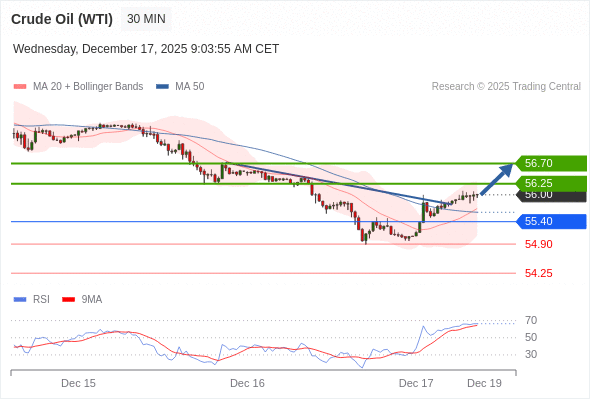WTI
USOIL55.842USD
Today
+1.46%
5 Days
-3.97%
1 Month
-6.43%
6 Months
-20.16%
Year to Date
-21.92%
1 Year
-20.39%
Key Data Points
Opening Price
55.104Previous Closing Price
55.039Indicators
The Indicators feature provides value and direction analysis for various instruments under a selection of technical indicators, together with a technical summary.
This feature includes nine of the commonly used technical indicators: MACD, RSI, KDJ, StochRSI, ATR, CCI, WR, TRIX and MA. You may also adjust the timeframe depending on your needs.
Please note that technical analysis is only part of investment reference, and there is no absolute standard for using numerical values to assess direction. The results are for reference only, and we are not responsible for the accuracy of the indicator calculations and summaries.
WTI Trading Strategy

Trading Strategy
Long positions above 55.40 with targets at 56.25 & 56.70 in extension.
Alternative scenario
below 55.40 look for further downside with 54.90 & 54.25 as targets.
Comment
long positions above 55.40 with targets at 56.25 & 56.70 in extension.
WTI News
WTI climbs above $55.50 as Trump orders blockade of sanctioned Venezuelan oil tankers
West Texas Intermediate (WTI), the US crude oil benchmark, is trading around $55.75 during the Asian trading hours on Wednesday. The WTI price climbs amid rising volatility around Latin American crude supply.

US President Donald Trump orders total blockade of sanctioned Venezuelan oil tankers
US President Donald Trump ordered a blockade of all sanctioned oil tankers entering and leaving Venezuela, Reuters reported late Tuesday.

WTI nears year-to-date lows on Russia-Ukraine peace optimism
West Texas Intermediate (WTI) Crude Oil remains under pressure on Tuesday, extending its decline for a fourth consecutive day as persistent oversupply concerns continue to dominate market sentiment.

Oil: Brent Crude falls below $60 for first time in over seven months – Commerzbank
Brent Crude fell below $60 per barrel this morning, marking the lowest level in more than seven months, while WTI closed at its weakest since February 2021.

Oil: Ceasefire hopes push Brent to six-month low – Commerzbank
Renewed optimism over a Russia-Ukraine ceasefire weighed on the Oil market yesterday. ICE Brent settled a little more than 0.9% lower, leaving it at $60.56/bbl -- the lowest close since May.

WTI declines below $56.50 on potential Russia-Ukraine peace deal
West Texas Intermediate (WTI), the US crude oil benchmark, is trading around $56.35 during the Asian trading hours on Tuesday. The WTI price remains under selling pressure amid renewed signs of optimism surrounding a deal to end the war in Ukraine.

More Details of WTI
How does the price of USOIL fluctuate?
The price of USOIL can fluctuate due to several factors, including global supply and demand, OPEC production levels, geopolitical tensions, economic growth, currency fluctuations, and changes in inventory levels.


